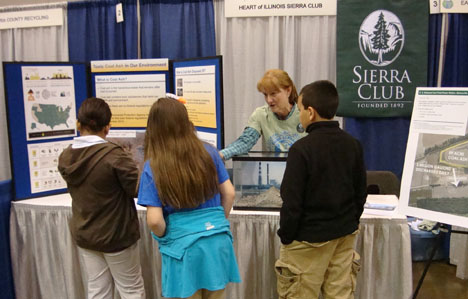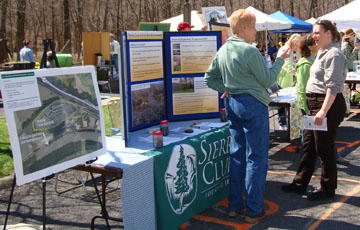May 2014

Heart of Illinois Group volunteers brought an educational message and display about the harmful effects of coal ash waste from coal fired power plants to hundreds of people in Earth Day related events during April. We did tabling at Forest Park Nature Center in Peoria Heights on April 19, the Peoria Zoo on April 27, and the Clean Water Celebration at the Peoria Civic Center on April 28. The Clean Water Celebration is an annual event sponsored by the Sun Foundation for over 2,000 local grade school students and their teachers.
The title of our display was “Toxic Coal Ash in Our Environment”, which explained what coal ash is, how it is disposed of, how humans are exposed to it, and it’s negative health impacts. The display included samples of two types of coal ash. Fly ash is scrubbed from flue gases before it goes up the smokestack, and heavier bottom ash remains at the bottom of the furnace after the coal is burned.
U.S. power plants produce 140 million tons of coal ash per year, enough to fill a freight train stretching from the North Pole to the South Pole. Coal ash contains toxic heavy metals such as lead, mercury, arsenic, and chromium. Approximately 36% is disposed of in dry landfills, 21% is mixed with water and stored in waste ponds, and 43% is “recycled” in engineering, manufacturing, agricultural and other applications, and used in products such as concrete and wallboard. There are currently no federal regulations on toxic coal ash. The Environmental Protection Agency has agreed to finalize the first-ever federal regulations on coal ash by December 2014.

Our display focused on the E. D. Edwards coal fired power plant in Bartonville, which generates 250,000 tons of fly ash per year! It has an 89 acre, unlined coal ash waste pond and is allowed by permit to release up to 5 million gallons per day of water runoff from the pond and other power plant processes into the Illinois River.
Special thanks to John Wosik for all his work on the excellent display panels. Thanks to Wendy, Chris, Bob, Diane, and Joyce who donated a lot of hours to talk about our local concerns on coal ash ponds along the Illinois River.